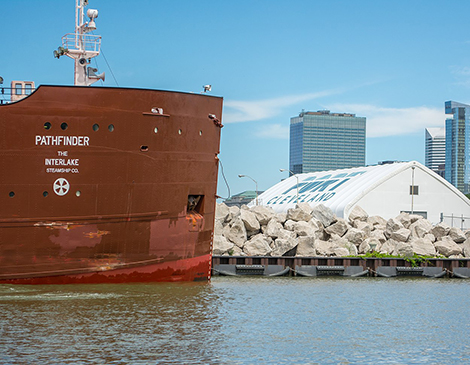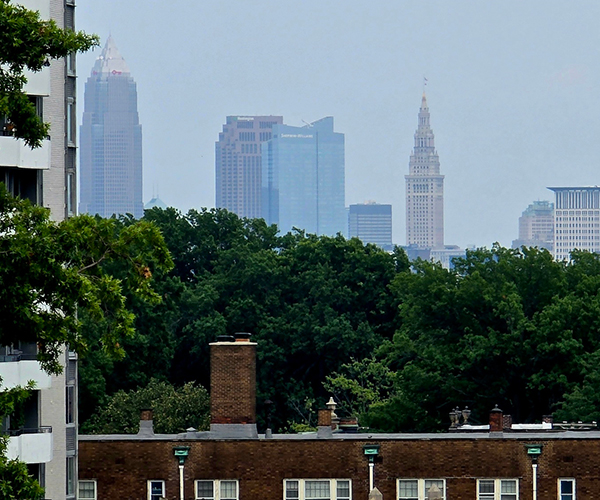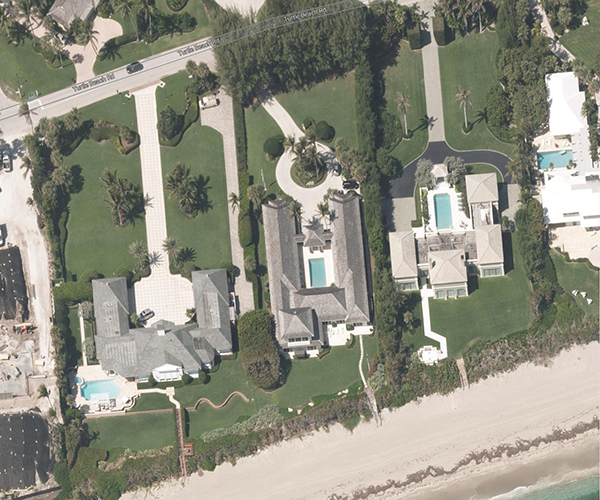In late April and early May, major economic ports on the West Coast, such as those in Seattle, Long Beach and Los Angeles, experienced significant declines in imports due to tariffs imposed by the Trump administration on China. Seattle’s port — normally bustling with vessels and colorful rows of shipping containers — appeared nearly empty.
Ports on the East Coast have also been affected by the tariffs. Sea-Intelligence, a maritime research group, reported in early May that ocean liners had canceled about 17% of their container ships scheduled to travel to East Coast ports.
The Port of Cleveland, on the other hand, being a seasonal port, was not affected in April and May because most of its cargo had been booked and sold before the tariffs took effect, says David Gutheil, interim president and CEO of the organization.
Additionally, the port benefits from its connection to the Atlantic Ocean and Europe, along with Cleveland’s proximity to Canada — linking the region to its two largest trade partners. Gutheil said that the port gets some imports from Asia, as well as from Sweden, the United Kingdom, Germany, the Netherlands and Belgium.
In late June, officials from the Port of Cleveland signed a strategic agreement with Ireland’s second-largest port operator. This strategic agreement will strengthen trade between Cleveland and the European Union, unlocking additional business and economic opportunities for both regions.
“Together we provide access to two huge international markets that present enormous opportunity for business development,” Gutheil told NEOTrans. “In signing this MOU, we want to explore every opportunity to strengthen that connection and drive business development on both sides of the Atlantic. We’re genuinely really excited about what’s ahead and confident in the mutually benefits this collaboration can deliver.”
Another benefit for the Port of Cleveland is that it is part of Foreign Trade Zone 40. These trade zones allow products to be held in the United States without incurring any tariffs. This is due to the fact that the FTZs are considered outside the commerce of the U.S. Once imports leave the FTZ, they are subject to tariffs.
Cleveland Magazine caught up with Gutheil in June to discuss The Port of Cleveland and how tariffs are affecting it, as well as the $4.7 billion in annual activity generated by moving cargo through the harbor each year.
Cleveland Magazine: When it comes to the cargo for the Port of Cleveland, are there any predictions going forward?
David Gutheil: Probably have a slower June, may have a slower July. The cargo that's moving now is impacted by the tariffs much more than the cargo we saw in April and May. So now we're in kind of a period of uncertainty as to what's going to happen the rest of the year.
CM: How much uncertainty?
DG: I'm hoping we reach our tonnage levels that we had last year. It wouldn't surprise me if we were down a little bit. But on the other hand, if the president and his administration come to trade agreements with a lot of these countries that are affected by the tariffs, maybe that loosens things up, and we could grow our cargo. There might be a big rush at the end of the year after the tariffs are changed, if and when that happens.
CM: You brought up a good point. Some countries are in the process of making trade deals. Some have already made deals, obviously with Canada and Europe being your top importers. Are you constantly monitoring the situation of the tariffs?
DG: Yes. Our customers, they're probably monitoring it closer than we are, frankly, because they're the ones that are paying for the cargo. Even at the foreign trade zone seminar we had yesterday morning in Lorain, everything is so fluid; it changes by the day, it seems. And that's the toughest thing for cargo owners and logistics companies to figure out. If you say, “OK, if we're going to have 50% tariff and that's going to remain in place,” and boom, that's it, well, all of a sudden 50% turns into 100%. It turns into 125%, and then maybe it goes down to 75%. It's very unpredictable right now, which is the problem. Supply chains do not like unpredictability. They like predictability. And when you throw changes into the supply chain, that creates a domino effect all the way down the road.

RELATED: Life Aboard the Great Lakes' Newest Cargo Ship
CM: I saw that Crain’s reported an increase in FTZs for the port in May. Is that still the case?
DG: I've gotten more calls about foreign trade zones in the last three months than in the last two years combined, because of the tariffs.
CM: How do FTZs help the Northeast Ohio economy?
DG: There are a couple of ways to look at it. Is it helping the economy because of the companies that are bringing the goods in, who are operating in Northeast Ohio and owned in Northeast Ohio, that they're saving money, so they're reducing the cost of the final product that consumers are buying? Sure. Then it's helping the economy. Is it helping those individual companies? Yes. Because they either receive the cashflow benefit or they're reducing the duty on the goods they're paying altogether. Is it helping us? Yeah, to a certain extent, because we're handling more cargo.
CM: Has your job been hectic because of the increased interest in setting up FTZs?
DG: No. Well, it's a double-edged sword. It is hectic because I'm interim president, CEO and chief commercial officer, so I'm doing both jobs right now. Okay. But yeah, is it a little more hectic because of the foreign trade zone interest? Sure, sure. We're just getting a lot more calls, but it is a good hectic. You are working on something that's going to benefit companies in Northeast Ohio, and it's benefiting the revenues that we derive from the foreign trade zone program. It's benefiting our terminal operator and the longshore and down at the port if we handle more goods through the port.
CM: That’s something I was curious about. If the goods are still sitting there because of the FTZs. Would trucking companies be hurt because the goods aren’t moving?
DG: Well, they will have something to transport. They're just doing it, maybe two months later than they usually would. It's the same cargo coming in instead of going out tomorrow or Friday. It's going out, possibly sometime in mid-to-late July instead.
CM: I saw that during COVID, we also benefited because the coastal ports were more loaded, and companies obviously needed to figure out how to get their goods in, and they came here. What makes the Cleveland Port such a strategic port? With these issues of COVID-19 and now the tariffs, to be able to say, “Hey, we’re open. We can do this.”
DG: Well, the biggest reason is because if you're a Northeast Ohio-based company, you'd rather bring your cargo in to a Northeast Ohio port and have your goods be unloaded from a ship that's in your own neighborhood, so to speak, rather than 300 miles away in New York or Norfolk, Virginia, or even further away in Savannah, Georgia, or somewhere else. So the benefit is more of a localized convenience solution. Typically, inland ports are not nearly as busy, even during downtime, as the big coastal ports are. That lack of congestion that we have versus the congestion issues that the big ports have means that we can cycle our cargo through our facility quicker and get that cargo to the end user quicker.
For more updates about Cleveland, sign up for our Cleveland Magazine Daily newsletter, delivered to your inbox six times a week.
Cleveland Magazine is also available in print, publishing 12 times a year with immersive features, helpful guides and beautiful photography and design.

.jpg?sfvrsn=f376fa8c_1&w=475&auto=compress%2cformat)


